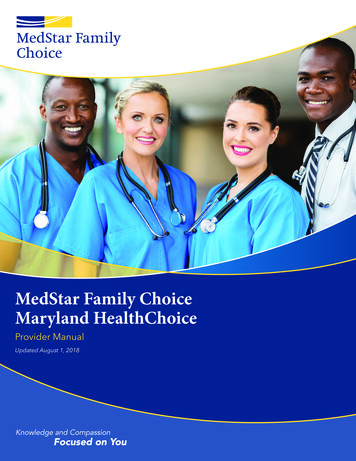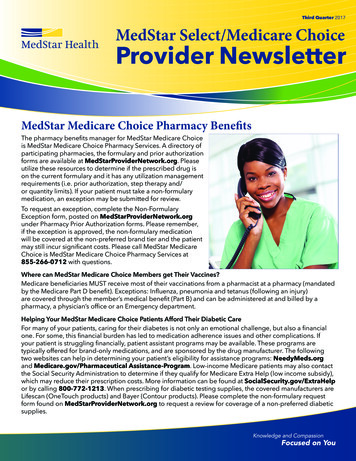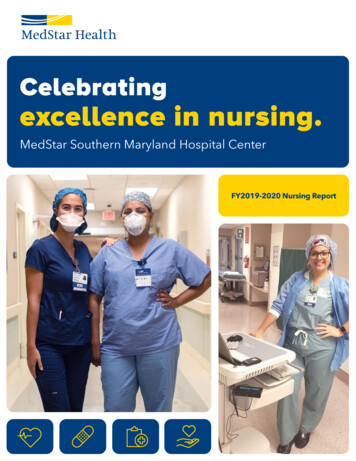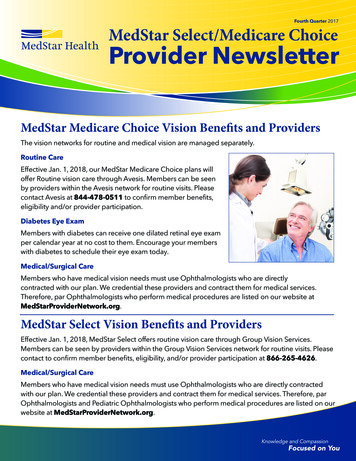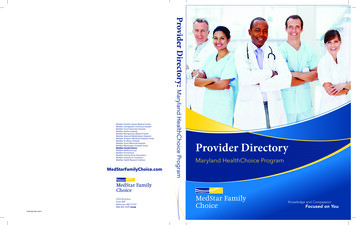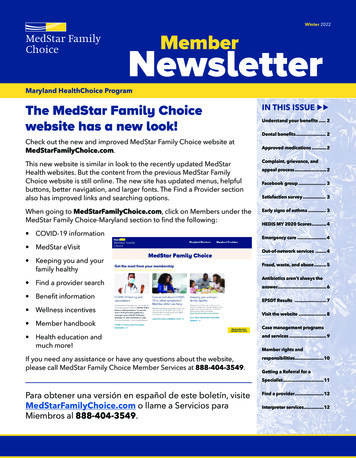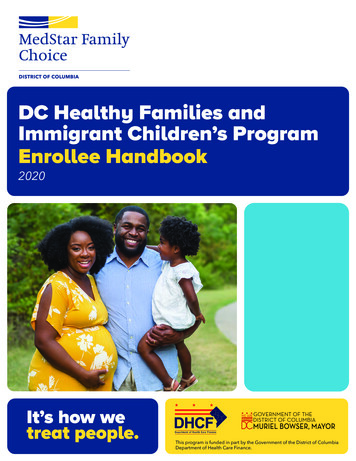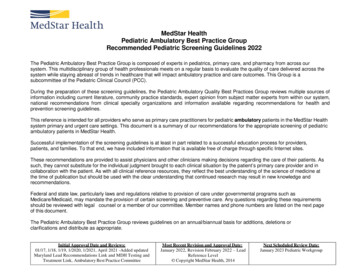
Transcription
MedStar HealthPediatric Ambulatory Best Practice GroupRecommended Pediatric Screening Guidelines 2022The Pediatric Ambulatory Best Practice Group is composed of experts in pediatrics, primary care, and pharmacy from across oursystem. This multidisciplinary group of health professionals meets on a regular basis to evaluate the quality of care delivered across thesystem while staying abreast of trends in healthcare that will impact ambulatory practice and care outcomes. This Group is asubcommittee of the Pediatric Clinical Council (PCC).During the preparation of these screening guidelines, the Pediatric Ambulatory Quality Best Practices Group reviews multiple sources ofinformation including current literature, community practice standards, expert opinion from subject matter experts from within our system,national recommendations from clinical specialty organizations and information available regarding recommendations for health andprevention screening guidelines.This reference is intended for all providers who serve as primary care practitioners for pediatric ambulatory patients in the MedStar Healthsystem primary and urgent care settings. This document is a summary of our recommendations for the appropriate screening of pediatricambulatory patients in MedStar Health.Successful implementation of the screening guidelines is at least in part related to a successful education process for providers,patients, and families. To that end, we have included information that is available free of charge through specific Internet sites.These recommendations are provided to assist physicians and other clinicians making decisions regarding the care of their patients. Assuch, they cannot substitute for the individual judgment brought to each clinical situation by the patient’s primary care provider and incollaboration with the patient. As with all clinical reference resources, they reflect the best understanding of the science of medicine atthe time of publication but should be used with the clear understanding that continued research may result in new knowledge andrecommendations.Federal and state law, particularly laws and regulations relative to provision of care under governmental programs such asMedicare/Medicaid, may mandate the provision of certain screening and preventive care. Any questions regarding these requirementsshould be reviewed with legal counsel or a member of our committee. Member names and phone numbers are listed on the next pageof this document.The Pediatric Ambulatory Best Practice Group reviews guidelines on an annual/biannual basis for additions, deletions orclarifications and distribute as appropriate.Initial Approval Date and Reviews:01/17, 1/18, 1/19, 1/2020, 1/2021, April 2021 -Added updatedMaryland Lead Recommendations Link and MDH Testing andTreatment Link, Ambulatory Best Practice CommitteeMost Recent Revision and Approval Date:January 2022, Revision February 2022 – LeadReference Level Copyright MedStar Health, 2014Next Scheduled Review Date:January 2023 Pediatric Workgroup
Pediatric Clinical Council Sub- Committee: Pediatric Ambulatory Best Practice Group MembersChair:Lee Fireman, MDMedStar Health- MFSMC443-777-2037Marques HattonMartha Johnson, MDJanine Rethy, MDJanine Rethy, MDMedStar Health- ISMedStar Health- MFSMC443-257-4790443-777-2037MedStar Health- GUH202-444-8888Patryce Toye, MDMedStar Family Choice - MFC443-933-2204Ann Hellerstein, MDMedStar Health- MMMG301-774-5800Nneka Holder, MDMedStar Health- GUH202-243-3465Ami Patel, MDMedStar Health- GUH202-243-3406Dahlia Halim, MDMedStar Health- MMG Bel Air410-668-1918Greg Dohmeier, DOMedStar Family Choice - MFC443-933-3039Barbara AydMedStar Health – MMG Federal Hill410-230-7815Max Smith, PharmDMedStar Health – GUH202-244-9831Shahira Ghobrial, PharmDMedStar Health- GUH202-444-1515Members:Initial Approval Date and Reviews:01/17, 1/18, 1/19, 1/2020, 1/2021, April 2021 -Added updatedMaryland Lead Recommendations Link and MDH Testing andTreatment Link, Ambulatory Best Practice CommitteeMost Recent Revision and Approval Date:January 2022, Revision February 2022 – LeadReference Level Copyright MedStar Health, 2014Next Scheduled Review Date:January 2023 Pediatric Workgroup
Pediatric PopulationsGUIDELINEPreventive Service1-18 MONTHS18 MONTHS - 21 YEARSWell Child CareVisit ScheduleNewborn, 3-5 days, by 1 mo., 2 mo., 4 mo.,6 mo., 9 mo., 12 mo., 15 mo., 18 mo.2 yrs., 30 months, and annually from age 3 years to 21 yearsReview of History: PastMedical andFamily HistoryEvery visitEvery visitPhysical ExamEvery visitEvery visitLength, Height and Weightwith percentileEvery visitEvery visit.Head Circumferencewith percentileEvery visit through 24 monthsContinue if abnormal head size is detectedWeight for LengthBMI with percentileEvery visit through 18 monthsBlood Pressure ScreeningRisk Assessment every visit through 30 ing byStandardized ToolEvery visit except 9, 18 and 30 months whenEvery visit except 9, 18 and 30 months when complete screening: Assesscomplete screening: Assess DevelopmentDevelopmentDevelopmental screening should be administered regularly at the 9, 18, and 30-month well visits utilizing a valid and standardizedscreening tool such as Ages and Stages Questionnaire (ASQ), Parent Evaluation of Developmental Status (PEDS) or Child DevelopmentInventories (CDI).Psychosocial/BehavioralScreeningEvery visit: utilizing validated and standardized tools such as Strength and Difficulties Questionnaire (SDQ), Pediatric SymptomChecklist (PSC), Ages and Stages Questionnaire – Social/Emotional (ASQ-SE), Early Childhood Screening Assessment (ECSA)Family Wellbeing/SocialDeterminants of HealthPost-Partum Depression: such as Edinburgh Post-Partum Depression Screen (EPDS) screen all well visits 2 weeks to 6 months age.Social Determinants of Health screening (such as in the MedConnect Well Child power form).Age-appropriate counseling should be discussed during periodic primary care physician visits. Additional screening andintervention may be necessary for individuals at high-risk. Risks (living situation and food security; tobacco, alcohol, and drugs; parentaldepression). Strengths and protective factors (family relationships and support, childcare)Anticipatory guidance, substance abuse, smoking, diet and exercise, injury prevention, domestic violence, dental health, appropriatescreen time, sexual behavior, use of alternative and complementary medicines, depression, suicidal/homicidal ideation, high-risk ofexposure to infectious diseases (HIV, Hep A, Hep B, Hep C). Safe sleep for infants.Anticipatory GuidanceCounseling / Education /Screening for high-riskfactors24 months, 30 months and then annually from age 3 years to 21 yearsInitial Approval Date and Reviews:01/17, 1/18, 1/19, 1/2020, 1/2021, April 2021 -Added updatedMaryland Lead Recommendations Link and MDH Testing andTreatment Link, Ambulatory Best Practice CommitteeEvery visit beginning at 3 years to 21 yearsMost Recent Revision and Approval Date:January 2022, Revision February 2022 – LeadReference Level Copyright MedStar Health, 2014Next Scheduled Review Date:January 2023 Pediatric Workgroup
AutismDepression ScreeningAdminister autism (ASD) specific screening tool on all children at the 18-month and 24-month preventive care visit such as MCHAT(Modified Checklist for Autism in Toddlers)Depression screening ages from 12-21 years of age should be performed annually utilizing validated and standardized tools such asStrength and Difficulties Questionnaire (SDQ), Pediatric Symptom Checklist (PSC), Patient Health Questionnaire 2 (PHQ-2), PatientHealth Questionnaire (PHQ-9, PHQ-9A), Teen Screen, or Guideline for Adolescent Preventive Services (GAPS) and should be assessed forsuicidal/homicidal ideationGenital ExamExternal genital exam: All ages and performed annuallyCervical Cancer ScreeningCervical cancer screening should begin at age 21 years (regardless of sexual history). Screening before age 21 should be avoided becausewomen less than 21 years old are at very low risk of cancer. Screening these women may lead to unnecessary and harmful evaluationand treatment (ACOG 2009, AAP 2014). For immunosuppressed patients screening may start earlier.Preventive ServiceNutritional Status/PhysicalActivity StatusHearingVisionDental HealthFluorideHepatitis CGUIDELINE1-18 MONTHS18 MONTHS - 21 YEARSEvery visit: Assess nutritional status and physical activity; counsel as appropriate.Subjective screening (validated): Newborn – 3 yrs., 7 yrs., 9 yrs.Objective Screening (validated): Newborn (confirm hearing test passed in hospital), 4 yrs., 5 yrs., 6 yrs., 8 yrs., 10 yrs., once between11 yrs. and 14 yrs., once between 15 yrs. and 17 yrs., once between 18 yrs. & 21yrs.*referto hearingscreeningif not performedSubjectivescreening:newborn-30months, elsewhere7 yrs., 9 yrs., 11 yrs., 13-14 yrs., 16-21 years.Objective testing: yearly 3-6 yrs. then every other year until age 12 yrs. & 15 years.Oral Health assessment should begin at birth and dental assessment begins at tooth eruption. Recommend dental providerassessment beginning at age 1 or earlier if dental concerns are present. Dentist evaluation should occur every 6 months. (AADP)Once teeth are present, fluoride varnish may be applied to all children every 3–6 months in the primary care or dental ent/134/3/626Screening for hepatitis C virus infection should be completed at least once between the ages of 18 and 79.Initial Approval Date and Reviews:01/17, 1/18, 1/19, 1/2020, 1/2021, April 2021 -Added updatedMaryland Lead Recommendations Link and MDH Testing andTreatment Link, Ambulatory Best Practice CommitteeMost Recent Revision and Approval Date:January 2022, Revision February 2022 – LeadReference Level Copyright MedStar Health, 2014Next Scheduled Review Date:January 2023 Pediatric Workgroup
Sexually TransmittedInfection (STI) RiskAssessment and ScreeningInfants born to mothers whose HIV status isunknown should be tested for HIV.Yearly risk assessment starting at age 11.Screening for all sexually active adolescents for STIs (includes gonorrhea, chlamydiaand HIV). Screen for syphilis in high risk sexually active patients.The USPSTF recommends HIV testing once for all adolescents between the ages of15-18 years.Those at increased risk of HIV infection, including those who are sexually active,participate in injection drug use or are being tested for other STIs, should be testedfor HIV and reassessed annually or more frequently based on benefits.htmlLead RiskAssessmentBlood Lead Testing6 mo., 9 mo., 12 mo., 15 mo., 18 mo. asrequired by stateBlood lead test at 9 to 12 months as required bystate or sooner if at high risk.24 months, 30 months and then annually from age 3 years thru 6 years as required bystateBlood lead test on or after 2 years age as required by state and repeated for anyone athigh risk Screening is recommended for previously untested children aged 6 years andrequired by most school districts for entry.Any blood lead screen 3.5 mcg/dL should have a follow up blood test per state.Hyperlinks below:2022 MD Guidance for New CDC Blood Lead Reference LevelMaryland Lead Recommendations,MDH Guidance for Testing and Treatment of Lead ExposureDC Lead Recommendations,VA Lead Recommendations,CDC Lead RecommendationsPreventive ServiceCyanotic CongenitalHeart Defect ScreeningGUIDELINE1-18 MONTHS18 MONTHS - 21 YEARSTuberculosisScreening/RiskAssessmentAll newborns are to be screened in the hospital. If screening is not able to be verified it should be performed in the outpatient setting.Perform TB screening /risk assessment by age 1 month, at 6 mos., 12 mos., and annually thereafter for all patients as required by state.High risk patients should be tested for TB. High risk patients can be defined as those that are immunocompromised, are or have beenin close contact with active TB cases, have medical risk factors, are immigrants from high prevalence areas, or have recently traveledto high-risk areas, and other disparate populations.Anemia Risk Assessment4 mo,15 mo., 18 mo. as required by stateInitial Approval Date and Reviews:01/17, 1/18, 1/19, 1/2020, 1/2021, April 2021 -Added updatedMaryland Lead Recommendations Link and MDH Testing andTreatment Link, Ambulatory Best Practice Committee24 mo., 30 mo., 3 yrs. and annually until age 21 years as required by stateMost Recent Revision and Approval Date:January 2022, Revision February 2022 – LeadReference Level Copyright MedStar Health, 2014Next Scheduled Review Date:January 2023 Pediatric Workgroup
Hematocrit or HemoglobinScreeningTest on or after 2 years age as required by state and repeated for anyone at high riskHematocrit or Hemoglobin testing at 9 to 12months and as required by state or if at highrisk.High risk populations can be defined as children who are: living in poverty, Black,Native American, Alaska native, immigrant, preterm and low birth weight infants,infants drinking cow’s milk.Females should be screened at least once after regular menstruation.Hereditary/Newborn MetabolicScreening (NMS)Newborn BilirubinCholesterol RiskAssessmentNMS should be done by 48 hours after birth.Results should be reviewed with appropriatefollow up. NMS recommendations varybetween states.Newborn - Confirm initial screening wasaccomplished, verify results, and follow up,as appropriate.Blood Lipid TestingDiabetes ScreeningUrinalysis e cell screen if not already completed, if status unknown or risk factors.24 months, 4 yrs., 6 yrs., 8 yrs., and then annually from age 12 years to 16 years asrequired by state2 to 21 years: Perform cholesterol screening at 9 -11 years and 17 - 20 years asrequiredby state and for high-risk patients with blood fasting lipid profile. Risk factors forpremature cardiovascular disease include obesity, high blood pressure, diabetes,family history of dyslipidemia and family history of premature cardiovasculardisease (malesScreeningwith fasting glucose and/or HbA1c every two years is recommended for 55yrsand female 65yrs).overweightindividual(BMI 85th percentile) and should also be based on other riskfactors such as lifestyle and/or family historyRoutine urinalysis to screen for kidney disease is not required.Screening pelvic exams are not recommended. Age-appropriatecontraceptive management should be offered as part of preventive healthmaintenance. App for phone: CDC – ContraceptionFor Complete CDC recommendations for Pediatric Immunizations go to; Apps for phone: CDC – Vaccine Schedules, Society for Teachers of Family Medicine – Shots ImmunizationsNote: For MedStar Health providers use of the MedConnect Well Child powerforms in Cerner are recommended for all well visits asthese include many of the above preventative screening recommendations.Initial Approval Date and Reviews:01/17, 1/18, 1/19, 1/2020, 1/2021, April 2021 -Added updatedMaryland Lead Recommendations Link and MDH Testing andTreatment Link, Ambulatory Best Practice CommitteeMost Recent Revision and Approval Date:January 2022, Revision February 2022 – LeadReference Level Copyright MedStar Health, 2014Next Scheduled Review Date:January 2023 Pediatric Workgroup
Notes & Resources1.American Academy of Pediatrics, 2021. Bright Futures screening and assessments. Retrieved fromhttps://downloads.aap.org/AAP/PDF/periodicity schedule.pdf2.American Academy of Pediatrics, 2020. Pediatric screening and assessments. Retrieved /Periodicity-Schedule.aspxAHRQ, (2015). Autism and developmental delays. Retrieved val/what-we-learned/pa-specialinnovation.html2007 Expert Committee recommendations Regarding the Prevention assessment, and Treatment of Child and Adolescent Overweight and Obesity: SummaryReport Retrieved from /Supplement 4/S164.fullAHRQ, (2012). Methods for insulin delivery and glucose monitoring: Comparative effectiveness. Retrieved sulin-blood-sugar-2010/research AHRQ Systematic Review Surveillance Program Retrieved ault/files/related files/insulin-blood-sugar-2010 surveillance.pdfAmerican Academy of Pediatric Dentistry, Latest Revision 2021. Perinatal and Infant Oral Health Care. Retrieved es guidelines/bp perinataloralhealthcare.pdfAmerican Academy of Pediatric Dentistry, Latest Revision 2020. Guideline on adolescent oral health care. Retrieved es guidelines/bp adoleshealth.pdfAmerican Academy of Pediatric Dentistry, 2016. Guideline on oral health care for the pregnant adolescent. Retrieved from -adolescent/American college of Obstetricians and Gynecologists, 2018 (Reaffirmed in 2020). Cervical Cancer Screening (Update). Retrieved er-screening-updateDistrict of Columbia Preventive Pediatric Health Care, 2021. DC Health Check periodicity schedule. Retrieved lthCheck-Periodicity-10-21.pdfDistrict of Columbia Health Check resources, 2020. Training and resource center. Retrieved from iodicity.htmlCenters for Disease Control and Prevention, (last reviewed 2020). Information for healthcare providers: Pediatric developmental screening. Retrieved nia EPSDT program, 2017. EPSDT provider manuals. Retrieved /wps/portal/ProviderManual/!ut/p/z1/04 R1NXYAcIwMf%20E 1wsAIDHMDRQDKGP14FEThNz5cP4qQEi 9qPSc ISEvZ0FBIS9nQSEh/p0/IZ7 JP4A1B01M0EF10%20A3A5D01M20D3 CZ6 JP4A1B01M0EF10A3A5D01M20L4 LA0 Ejavax.servlet.include.path info!QCPVAProviderManualsPortletView.jsp /U.S. Department of Health and Human Services. EPSDT listing by state. Retrieved from h t t p s : / / e c l k c . o h s . a c f . h h s . g o v / p h y s i c a l -treatment-epsdtAmerican Academy of Pediatrics. National Center for Medical Home Implementation: Medical Home Overiew. Retrieved /default.aspxCenter for Disease Control. Screening young children for lead poisoning: Guidance for state and local public health officials.Retrieved from g.htmCenter for Disease Control, (last reviewed 2021). Screening for lead during the domestic medical examination for newly arrived refuges. Retrieved elines/lead-guidelines.htmlVirginia Guidelines Testing Virginia Children for Lead ExposureRetrieved from 0.11.12.13.14.15.16.17.18.Initial Approval Date and Reviews:01/17, 1/18, 1/19, 1/2020, 1/2021, April 2021 -Added updatedMaryland Lead Recommendations Link and MDH Testing andTreatment Link, Ambulatory Best Practice CommitteeMost Recent Revision and Approval Date:January 2022, Revision February 2022 – LeadReference Level Copyright MedStar Health, 2014Next Scheduled Review Date:January 2023 Pediatric Workgroup
19. 2020 Maryland Guidelines for the Assessment and Management of Childhood Lead Exposure Retrieved MBP/2021/03/03/file attachments/1712219/MDHGuidelinesChildhoodLead 2020 Final.pdf20. CDC Childhood Lead Poisoning Prevention Program Retrieved fromhttps://www.cdc.gov/nceh/lead/default.htm21. Lead Exposure and Healthy Homes – Diagnosing & Managing Lead Exposures Retrieved fromhttps://doee.dc.gov/node/61331222. U. S. Preventive Services Task Force, 2016. Major depressive disorder in children and adolescents.Retrieved from f/uspschdepr.htmAn update for this topic is in progress Retrieved xiety-suicide-risk-children-adolescents23. U.S. Preventive Services Task Force (USPSTF), January 2017. Screening for Obesity in Children and Adolescents.Retrieved from 263251124. U.S. Preventive Services Task Force (USPSTF) July 2016. Lipid Disorders in Children and Adolescents: Screening.Retrieved from ers-in-children-screening125. Expert Panel on Integrated Guidelines for Cardiovascular Health and Risk Reduction inChildren and Adolescents: Summary report. Retrieved /128/Supplement 5/S213#sec-126. Adolescent Sexual Health. Retrieved from ntraception.aspx#: :text ntraceptive%20use.27. Center for Disease Control, 2016. U.S. selected practice recommendations for contraceptive use, 2016. Retrieved 1.htmUpdate 2021: m?s cid mm7020a2 w28. Pediatrics, 2010. A cost effectiveness analysis of screening urine dipsticks in well childcare. Pediatrics, April 1, 2010, 125(4), 660-663.Retrieved from 4/660.full29. National Heart and Lung Institute, 2012. Expert panel on integrated guidelines for cardiovascular health and risk reduction in children and adolescents.Retrieved from http://www.nhlbi.nih.gov/files/docs/peds guidelines sum.pdfRecommended Uniform Screening Panel Core /uniform-screening-panel.pdfInitial Approval Date and Reviews:01/17, 1/18, 1/19, 1/2020, 1/2021, April 2021 -Added updatedMaryland Lead Recommendations Link and MDH Testing andTreatment Link, Ambulatory Best Practice CommitteeMost Recent Revision and Approval Date:January 2022, Revision February 2022 – LeadReference Level Copyright MedStar Health, 2014Next Scheduled Review Date:January 2023 Pediatric Workgroup
MedStar Health- IS 443-257-4790 Martha Johnson, MD MedStar Health- MFSMC 443-777-2037 Janine Rethy, MD MedStar Health- GUH 202-444-8888 Patryce Toye, MD MedStar Family Choice - MFC 443-933-2204 Ann Hellerstein, MD MedStar Health- MMMG 301-774-5800 Nneka Holder, MD MedStar Health- GUH 202-243-3465
